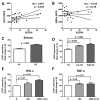CD47 Potentiates Inflammatory Response in Systemic Lupus Erythematosus
- PMID: 34068752
- PMCID: PMC8151692
- DOI: 10.3390/cells10051151
CD47 Potentiates Inflammatory Response in Systemic Lupus Erythematosus
Abstract
Background: To investigate the role of CD47 in inflammatory responses in systemic lupus erythematosus (SLE).
Methods: Expression of CD47 and signal regulatory protein alpha (SIRPα) by peripheral blood mononuclear cells (PBMCs) and changes in CD47 expression after exposure to SLE serum, healthy control (HC) serum, recombinant interferon (IFN)-α, or tumor necrosis factor (TNF)-α were examined. Human monocytes and THP1 cells were incubated with lipopolysaccharide (LPS), an anti-CD47 antibody, or both. TNF-α production was examined. Sera from SLE patients and HCs were screened to detect autoantibodies specific for CD47.
Results: Twenty-five SLE patients and sixteen HCs were enrolled. CD47 expression by monocytes from SLE patients was higher than those from HCs (mean fluorescence intensity ± SD: 815.9 ± 269.4 vs. 511.5 ± 199.4, respectively; p < 0.001). CD47 expression by monocytes correlated with SLE disease activity (Spearman's rho = 0.467, p = 0.019). IFN-α but not TNF-α, increased CD47 expression. Exposing monocytes to an anti-CD47 antibody plus LPS increased TNF-α production by 21.0 ± 10.9-fold (compared with 7.3 ± 5.5-fold for LPS alone). Finally, levels of autoantibodies against CD47 were higher in SLE patients than in HCs (21.4 ± 7.1 ng/mL vs. 16.1 ± 3.1 ng/mL, respectively; p = 0.02). Anti-CD47 antibody levels did not correlate with disease activity (Spearman's rho = -0.11, p = 0.759) or CD47 expression on CD14 monocytes (Spearman's rho = 0.079, p = 0.838) in patients.
Conclusions: CD47 expression by monocytes is upregulated in SLE and correlates with disease activity. CD47 contributes to augmented inflammatory responses in SLE. Targeting CD47 might be a novel treatment for SLE.
Keywords: CD47; SIRP-alpha; inflammatory response; systemic lupus erythematosus.
Conflict of interest statement
The authors declare that they have no competing interests.
Figures





Similar articles
-
Regulation of CD47 expression on CD14+ monocytes by interferon-α in PBC patients.Front Immunol. 2023 Dec 4;14:1256995. doi: 10.3389/fimmu.2023.1256995. eCollection 2023. Front Immunol. 2023. PMID: 38111586 Free PMC article.
-
Interferon-induced protein IFIT4 is associated with systemic lupus erythematosus and promotes differentiation of monocytes into dendritic cell-like cells.Arthritis Res Ther. 2008;10(4):R91. doi: 10.1186/ar2475. Epub 2008 Aug 15. Arthritis Res Ther. 2008. PMID: 18706081 Free PMC article.
-
BAFF-R and TACI expression on CD3+ T cells: Interplay among BAFF, APRIL and T helper cytokines profile in systemic lupus erythematosus.Cytokine. 2019 Feb;114:115-127. doi: 10.1016/j.cyto.2018.11.008. Epub 2018 Nov 19. Cytokine. 2019. PMID: 30467093
-
Monocyte surface expression of Fcgamma receptor RI (CD64), a biomarker reflecting type-I interferon levels in systemic lupus erythematosus.Arthritis Res Ther. 2010;12(3):R90. doi: 10.1186/ar3017. Epub 2010 May 18. Arthritis Res Ther. 2010. PMID: 20478071 Free PMC article.
-
Vasculitis in systemic lupus erythematosus (SLE)--assessment of peripheral blood mononuclear cell activation and the degree of endothelial dysfunction: initial report.Postepy Hig Med Dosw (Online). 2007 Dec 3;61:725-35. Postepy Hig Med Dosw (Online). 2007. PMID: 18063917
Cited by
-
Regulation of CD47 expression on CD14+ monocytes by interferon-α in PBC patients.Front Immunol. 2023 Dec 4;14:1256995. doi: 10.3389/fimmu.2023.1256995. eCollection 2023. Front Immunol. 2023. PMID: 38111586 Free PMC article.
-
UC-BSCs Exosomes Regulate Th17/Treg Balance in Patients with Systemic Lupus Erythematosus via miR-19b/KLF13.Cells. 2022 Dec 19;11(24):4123. doi: 10.3390/cells11244123. Cells. 2022. PMID: 36552891 Free PMC article.
-
Signal Regulatory Protein α Expression in Systemic Vasculitis.ACR Open Rheumatol. 2024 Oct;6(10):634-640. doi: 10.1002/acr2.11716. Epub 2024 Jul 15. ACR Open Rheumatol. 2024. PMID: 39010674 Free PMC article.
-
CD47 blockade ameliorates autoimmune vasculitis via efferocytosis of neutrophil extracellular traps.JCI Insight. 2023 Aug 8;8(15):e167486. doi: 10.1172/jci.insight.167486. JCI Insight. 2023. PMID: 37368493 Free PMC article.
-
Accurate Machine Learning Model to Diagnose Chronic Autoimmune Diseases Utilizing Information From B Cells and Monocytes.Front Immunol. 2022 Apr 20;13:870531. doi: 10.3389/fimmu.2022.870531. eCollection 2022. Front Immunol. 2022. PMID: 35515003 Free PMC article.
References
Publication types
MeSH terms
Substances
Grants and funding
LinkOut - more resources
Full Text Sources
Other Literature Sources
Medical
Research Materials

